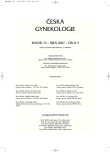Determination Concentrations of Tissue Factor Pathway Inhibitor and their Changes during Estrogen Replacement Therapy
Stanovení hladin TFPI a jejich změny při estrogenní substituční terapii
Cíl:
Cílem studie bylo zjistit změny hladin tissue factor pathway inhibitoru (TFPI) jako biochemického rizikového faktoru pro tromboembolii při různých aplikačních formách časně zahájené estrogenní substituční terapie.
Typ studie:
Prospektivní randomizovaná dvojitě slepá studie s cross-over designem.
Pracoviště:
Všeobecná fakultní nemocnice v Praze.
Metoda.
V prospektivní randomizované 12týdenní intervenční studii byl v cross-over designu podáván estradiol perorálně v dávce 2 mg denně nebo transdermálně v dávce 0,05 mg denně. Zařazeno bylo 45 zdravých postmenopauzálních žen do 12 týdnů od odstranění dělohy a vaječníků (chirurgické kastrace). Studii dokončilo 41 žen a jejich data byla analyzována. Průměrný věk byl 49 ± 6 let. TFPI bylo stanoveno enzymaticky (Imubind Total TFPI ELISA test).
Výsledky:
Po perorální terapii statisticky významně (p < 0,0001) klesla průměrná hladina TFPI z 87,5 ± 39,1 ng/ml na 68 ± 37,49 ng/ml.
Závěr:
Perorální terapie významně snížila hladiny TFPI ve srovnání s terapií transdermální. Ačkoli tyto změny nelze považovat za jednoznačně rizikové a nulová změna D-dimerů potvrzuje, že nedošlo k aktivaci koagulační kaskády, považujeme neutrální vliv transdermální terapie za příznivější. Chybění známek aktivace koagulační kaskády ukazuje bezpečnost obou aplikačních forem estrogenní substituční terapie při časném podání.
Klíčová slova:
estrogenní substituční terapie, tromboembolická nemoc, TFPI
Authors:
Tomáš Fait 1
; B. Trnková 3; M. Koštířová 3; M. Vráblík 2
Authors‘ workplace:
Gynekologicko-porodnická klinika VFN Praha a 1. LF UK, Praha, přednosta prof. MUDr. A. Martan, DrSc.
1; III. interní klinika VFN Praha a 1. LF UK, Praha, přednosta prof. MUDr. Š. Svačina, DrSc.
2; Ústav klinické biochemie VFN Praha a l. LF UK, Praha, přednosta prof. MUDr. T. Zima, DrSc.
3
Published in:
Ceska Gynekol 2007; 72(5): 343-347
Category:
Original Article
Overview
Objective:
The purpose of the present study was to determine changes of tissue factor pathway inhibitor (TFPI) as a biochemical risk factors of thromboembolism during the use of different administration methods of the early estrogen replacement therapy.
Design:
Prospective randomized cross-over trial.
Setting:
General Faculty Hospital Prague.
Methods:
In a 12-week prospective, randomized, interventional, cross-over trial, estradiol was administered orally in a dose of 2 mg daily or transdermally in a dose of 0,05 mg daily. Forty-five healthy postmenopausal women were included into the study within 12 weeks after the hysterectomy and ovariectomy (surgical castration). Forty-one women completed the study and their data were analyzed. The average age was of 49 ± 6 years. An enzymatic method (IMUBIND Total TFPI ELISA test) was employed for the determination of TFPI.
Results.
After the oral therapy, the average value of TFPI decreased statistically significantly (p <0.0001) from 87.5 ± 39.1 ng/ml to 68 ± 37.49 ng/ml. Conclusion: Statistically the oral therapy reduced significantly TFPI compared with the transdermal method of administration. In spite of the fact that these changes cannot be unambiguously considered as risky and that the zero change of D-dimers suggests that there was no activation of the coagulation cascade, we consider the neutral effect of the transdermal therapy as more beneficial. The lack of manifestations of the coagulation cascade activation demonstrates the safety of both administration forms of the estrogen replacement therapy in the case of the early administration.
Key words:
estrogen replacement therapy, thromboembolism, TFPI
Labels
Paediatric gynaecology Gynaecology and obstetrics Reproduction medicineArticle was published in
Czech Gynaecology

2007 Issue 5
Most read in this issue
- Inherited Metabolic Disorders and Pregnancy
- Da Vinci Robotic Surgery in Gynaecological Oncology: a Critical Interim Appraisal
- Basal-like Carcinoma of the Breast – the Actual Review and Clinico-Pathological Corelations
- Progression and Regression Low Grade Intraepitelial Squamous Lesions in Context of Positivity of High Risk Human Papillomavirus
